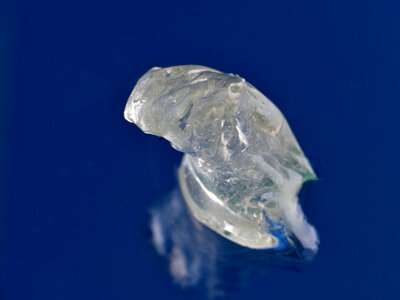
Posted on 08/06/2021 11:26:01 AM PDT by Red Badger

1,3-butadiene produced from bacteria. Credit: Yokohama Rubber The future environmental footprint of the tire industry could be substantially shrunk thanks to a new ecofriendly way found by four RIKEN researchers that harnesses bacteria to make a chemical used in synthetic rubber.
Each year, factories around the world churn out more than 12 million metric tons of the organic chemical 1,3-butadiene, which is used in tires, adhesives, sealants and other plastic and rubber products. They produce it by an energy-intensive process that relies on petroleum, which contributes to climate change.
Scientists have tried for many years to create 1,3-butadiene from more environmentally friendly starting materials by using specially designed microbes. But no one had previously succeeded in transforming a simple sugar such as glucose into the chemical in one easy step.
Now, by engineering bacteria to convert glucose into 1,3-butadiene, Yutaro Mori and his three co-workers, all at the RIKEN Center for Sustainable Resource Science, have devised a sustainable approach to rubber and plastic production.
"We constructed a novel artificial metabolic pathway and produced 1,3-butadiene directly from a renewable source—glucose," says Mori.
The RIKEN team succeeded in this long-sought goal by focusing on two parts of the biomanufacturing process. They first engineered a bacterial enzyme that could convert a biological compound that can be developed from glucose into 1,3-butadiene (Fig. 1). The researchers then modified a strain of the bacterium Escherichia coli to use this enzyme and produce the chemical. Since 1,3-butadiene is a gas at room temperature, it can be easily captured as the bacteria continue to divide and grow.
The technique still has a little way to go before it is ready for industrial primetime. The RIKEN team managed to synthesize only about 2 grams of 1,3-butadiene per liter of microbial brew. Much larger amounts will be needed for the method to be cost competitive with petroleum-based production.
But with some additional engineering and optimization, Mori believes his team will get there. They are now further tweaking the bacterium's metabolic pathways and enhancing the enzyme's efficiency. In collaboration with the companies Yokohama Rubber and Zeon Corporation, the RIKEN team is also scaling up the protocol to work with larger volumes of microbes.
The researchers are also exploring ways of harnessing the power of microbes to produce other chemicals from renewable resources. "After doing additional research into enzyme engineering and metabolic engineering, I hope we will be able to make a substantial contribution to realizing a low-carbon society and a sustainable bioeconomy in the not-so-distant future," says Mori.
Explore further
Clue for efficient usage of low-cost nickel catalysts
More information: Yutaro Mori et al, Direct 1,3-butadiene biosynthesis in Escherichia coli via a tailored ferulic acid decarboxylase mutant, Nature Communications (2021). DOI: 10.1038/s41467-021-22504-6
Journal information: Nature Communications
Provided by RIKEN
eColi. Ubiquitous in the gut. These engineered bacteria produce 1,3-butadiene gas. This could produce wind that would put Uo to shame.
Love, Anjin-san
If they could reverse the process there would be a lot of happy children.
I made it all the way to, “contributes to climate change.” The first use of “climate change” in its many variations is the full stop for me on any article.
That also speaks to a terrible concern if they are released and ingested.

I can’t wait for these bacteria escape the lab, colonize my digestive track, and I end up scrapping out rubber additives. Fun.
Ditto.😖
1,3-Butadienetruly is a toxic gas. From the inter-webs:
"1,3-Butadiene is a synthetic, colorless gas that is practically insoluble in water and soluble in ethanol, ether, acetone and benzene. It is used primarily as a monomer to manufacture many different types of polymers and copolymers and as a chemical intermediate in the production of industrial chemicals. When heated, 1,3-butadiene emits acrid fumes and is flammable. In the presence of air, it oxidizes to form explosive peroxides. The primary route of potential human exposure to this compound is inhalation. Acute exposure to 1,3-butadiene can cause irritation of the eyes, nasal passages and throat. At very high concentrations, inhalation of this gas can result in headache, fatigue, decreased blood pressure and pulse rate, central nervous system damage and unconsciousness. It is known to be a human carcinogen."
source https://pubchem.ncbi.nlm.nih.gov/compound/1_3-butadiene
Mutant 59.🙄
No wonder so many people carry a spare tire around.
Lol, I did the same thing. Too much emphasis on espionage in the J-schools, not enough on sentence diagramming and structure.
coincidentally I bought tires from TireRack the other day,
I noticed that the fine print said
As a service to our customers, Tire Rack registers the Department of Transportation (DOT) Tire Identification Numbers for you automatically [with the government]for tires purchased from us.
Tires fitted as Original Equipment on new vehicles are also automatically registered when the vehicle is purchased.
Then I wondered about RFID in tires, which I knew was in the planning stages, and now looks like only a few more years
Soon the serial numbers on tires will be remotely readable by rfid scanners, in addition to the normal cell phone tracking.
True, but license plate readers are already universally used and put into databases around the country.
No doubt. I realize we have a plastic and rubber problem but let’s hope this doesn’t lead to a widespread bacteria that lives on roadways and eats through our car tires every 3 months.
yes
however while criminals may swap/remove license plates or obscure vin numbers,
Who thinks about their own tires narcing on them ?
Ever wonder how much tire ends up on the side of the highway? A group of we engineers in Houston had this conversation once and took the time to estimate the volume. It is HUGE. We then wondered what happened to it all as the volume should create drifts of tire particles on the side of the highway. The reality is that it is consumed by microbes that then excrete it and it is washed away in solution with the water.
Yeah if you look at the outside margins of a car race track after an event you see what they call “marbles” or lots of rubber that has spalled off the tires. Of course when it all happens in a few hours it’s not gonna decompose quickly.
These guys on Youtube called “Neutral Drop” call the tire dust “pizza toppings”.
Disclaimer: Opinions posted on Free Republic are those of the individual posters and do not necessarily represent the opinion of Free Republic or its management. All materials posted herein are protected by copyright law and the exemption for fair use of copyrighted works.